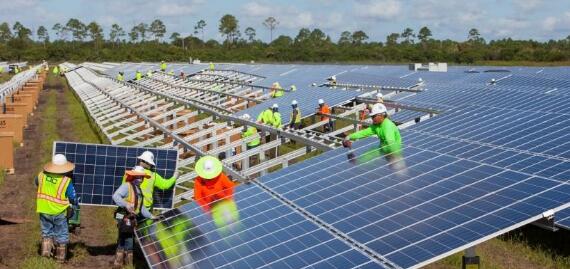NextEra Energy has announced its new decarbonisation strategy, dubbed Zero Carbon Blueprint, which includes eliminating all scope 1 and 2 emissions from its operations by 2045 without the use of carbon offsets and a massive increase in solar PV to 90GW by 2045.
Reaching the “Real Zero” goal, which NextEra has described as “the most ambitious carbon emissions reduction goal ever set by an energy producer”, will require “significant investment” in wind, solar, battery storage, nuclear, green hydrogen and other renewable sources, the company said in a statement.
It said the Real Zero target was dependent, however, on “no incremental cost to customers relative to alternatives” and its efforts being “supported by cost-effective technology advancements and constructive governmental policies and incentives”, despite its old CEO saying government support such as the Build Back Better was not essential to its goals.
The company has set interim milestones every five years to help support its progress to Real Zero, with it planning to reach a carbon emissions reduction rate of 70% by 2025, higher than its previously commitment. This would then increase to 82% in 2030, 87% by 2035 and 94% by 2040, before hitting Real Zero no later than 2045.
“We’ve worked hard in developing Real Zero to ensure we have a credible technical pathway to achieve our goals and well-defined milestones every five years so we and all stakeholders can track our progress,” John Ketchum, president and CEO of NextEra Energy.
Aside from scope 1 and 2 emissions – those related to an entity’s own operations and not linked to the operations of suppliers – NextEra has also pledged to make its scope 3 emissions, which derive from activities along its supply chain, more transparent.
It intends to do so by “working with supply chain partners as well as customers on solutions to reduce and, ultimately, eliminate these emission sources”.
The Florida-based US utility also said that on top of its internal Real Zero goal, the Zero Carbon Blueprint will seek to help decarbonise more of the US power sector through investments in renewable technologies as well as targeting a broader decarbonisation of the US economy.
Florida Power & Light Company fulcrum of strategy
Breaking down the plan even further, a “significant portion” is intended to take place at Florida Power & Light Company (FPL), which NextEra said was the US’s largest electric utility serving over 12 million Floridians.
FPL’s goal is to significantly accelerate the transformation of its generation mix, reaching 36% decarbonised by 2025, 52% by 2030, 62% by 2035 and 83% by 2040, culminating in 100% decarbonised by no later than 2045.
And it plans to do so through a massive increase of solar PV and battery storage. Currently, FPL generates almost 4GW of power from solar and NextEra wants to increase this number to 90GW by 2045. When it comes to battery storage, FLP is seeking to add more than 50GW of battery storage to FPL’s grid, up from 500MW today.
Additionally, there would be space for more nuclear power, while the present natural gas use of 16GW would be replaced by green hydrogen in a process that would “not result in any stranded generation assets,” NextEra said, which is seeking to become a “leader in green hydrogen production”.
“This isn’t a plan to plant trees or purchase offsets, but rather would be a complete elimination of our incremental carbon emissions in Florida to the benefit of our customers,” said Eric Silagy, chairman and CEO of FPL.
Overall, NextEra said its strategy was a “clear vision with real impact” and that it “has a clear head start due to decades of investments in and deployment of clean energy technologies”.
“We intend to leverage our playbook and our competitive advantage as a world leader in low-cost renewables and energy storage to drive the US economy toward a cleaner, more sustainable future,” added Ketchum.
NextEra Energy reveals decarbonisation strategy with 2045 ‘Real Zero’ target of 90GW solar PV, 50GW battery storage
NextEra Energy intends to increase its solar PV capacity more than 20-fold by 2045.
Source:PVTECH






